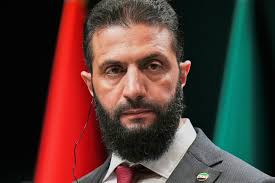Six months after the fall of Bashar al-Assad, Syria’s transitional government, led by President Ahmad al-Sharaa, stands at a precarious juncture. What was once a distant dream for many Syrians—the end of authoritarian rule—has ushered in a far more complex and morally fraught phase: the reconstruction of a state fractured by geography, ideology and collective memory.
Despite key diplomatic victories—most notably the lifting of U.S. and European sanctions—Sharaa’s administration faces a deepening crisis of legitimacy at home. While it has inherited the ruins of a state, it must also bear the weight of revolutionary expectations, lingering grievances, and intense international scrutiny. These contradictions are most visible across three interlinked domains: territorial governance, the contentious question of foreign fighters, and the delicate forging of a national identity under pressure.
A Government Without a Monopoly on Power
When Ahmad al-Sharaa entered Damascus in December 2024, he found not a capital of unified authority but a fragmented terrain of competing sovereignties. Four distinct power blocs—the central government, the Kurdish-led Autonomous Administration, Turkish-backed opposition groups in the north, and the Islamist-dominated Salvation Government in Idlib—continue to operate with their own militaries, economies and judicial systems.
While such decentralisation may have been inevitable, it has made the consolidation of national unity and institutional legitimacy profoundly difficult. Analysts such as Radwan Ziadeh argue that mere stabilisation in such a context would constitute a significant achievement. Yet, the interim government’s early tenure has been marred by sectarian bloodshed—most notably the massacres of Alawite and Druze civilians in early 2025, which claimed over 1,700 lives and eroded public confidence in the state’s ability to provide security.
The United States has pressed Sharaa to dismantle extremist factions still operating within Syrian territory—a demand that underscores international concern over the state’s limited control of its armed affiliates.
The Foreign Fighter Dilemma: Gratitude or Reckoning?
Few issues illustrate Syria’s transitional tensions as vividly as the status of foreign jihadist fighters.
Over the course of the war, thousands of non-Syrian militants joined the anti-Assad struggle—some driven by Islamist ideology, others by transnational solidarity. To some Syrians, these fighters are seasoned veterans who helped defend communities in key battles. To others, they are a destabilising presence whose continued role threatens the integrity of Syria’s emerging institutions.
President Sharaa’s decision—reportedly backed by the United States—to integrate a limited number of these fighters into the national army has provoked fierce opposition. Critics such as Maher al-Zoubi warn that such a move risks replicating the Assad-era security architecture, this time in the guise of a privatised military loyal to foreign patrons. Al-Zoubi questioned the logic of naturalising fighters who lack deep-rooted ties to Syrian society, describing the policy as a dangerous continuity with past failures.
Public unease is equally evident. Many Syrians have taken to social media to express concern not just over national security but over questions of justice and identity. Why, they ask, should those who once served under jihadist banners now be granted military authority? Why should communities devastated by war be asked to accept such compromises?
A Grassroots View: Between Condemnation and Compassion
Still, the moral landscape is more nuanced than many critics allow. A widely shared Facebook post by Syrian writer and influencer Mohammad Al-Salloum has offered a more empathetic take, reframing the issue as not merely political but deeply human. Many of these fighters, the post observed, have lived in Syria for more than a decade. Some have married Syrians, started families, and become part of the social fabric—not as militants, but as men in search of refuge after being cast out of their own homelands.
From this vantage point, calls for mass deportation or blanket criminalization seem both impractical and ethically fraught. “Is it not a betrayal,” the writer asked, “to discard those who fought and bled for a cause many Syrians once shared—especially when their home countries now refuse to repatriate them?”
The post concluded with a sober proposal: bar these individuals from military service, but allow those who have built civilian lives in Syria to remain legally—acknowledging their past without entrusting them with the future of the Syrian state.
Economic Recovery Amid International Pressure
Layered over these social and security dilemmas is Syria’s precarious economic recovery. When Sharaa took office, the country faced near-total economic collapse: an isolated financial system, devastated infrastructure, and a majority population living below the poverty line. Sanctions relief has brought modest gains—fuel supplies have stabilised, imports have resumed, and the dollar has returned to circulation—but the broader economic outlook remains bleak.
As economist Karam Shaar has warned, political stability alone is insufficient. Without a functioning legal system and clear investment frameworks, Syria will struggle to attract the capital required for serious reconstruction. The transitional government has pledged reforms in investment law and service provision—particularly in education, agriculture, and energy—but the scale of the challenge remains enormous.
At the same time, regional and international actors are pressuring Damascus to normalise ties with Israel—a move some suggest is essential for Syria’s full reintegration into the global order. But with Israeli airstrikes continuing and its occupation expanding in southern Syria, any prospect of rapprochement remains politically untenable and diplomatically remote.
Conclusion: A Leadership Defined by Contradiction
Ahmad al-Sharaa’s administration may have succeeded the Assad regime, but it has yet to dismantle the political architecture of fear, fragmentation and mistrust that it inherited. To do so, it must navigate competing imperatives: unity versus autonomy, justice versus pragmatism, sovereignty versus dependency.
This is the dilemma of post-revolutionary governance: that those who inherit the dream of freedom must also inherit the burden of compromise.
In the critical months ahead, Syria’s trajectory will hinge not only on the government’s ability to restore order, but on its capacity to articulate a vision of statehood that all Syrians—regardless of sect or allegiance—can claim as their own. Only then will the revolution transition from rupture to reconstruction, from resistance to republic.


